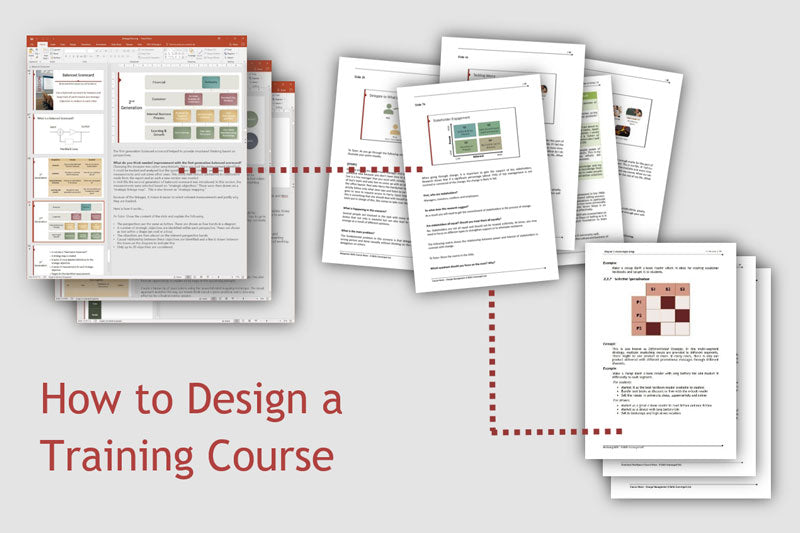There are many instructional design theories and it is easy to get lost in a sea of acronyms. When I was researching this area, it seemed that many of them are covering the same ideas and principles but present it with different jargons. The underlying research, approach to course design and the structures identified in such theories are nevertheless very useful. The real value in comparing instructional design theories is in comparing them. As soon as you put one approach to course design next to another, you begin to see the true value of each method and how each can help you in its own way.
My intention in this article is to present several commonly used instructional design methods. I want you to get a quick feel for what they are about and how they can help you with instructional design. I have provided pointers for further reading for each method as I intend to be brief here. You can also see a pattern as certain concepts are repeated over and over again, emphasising that they are indeed important for training design.
The intention is not to find the ultimate theory, or to see which one is correct. Instructional design theories are tools; use them based on your needs. Adapt, mix and match at it suits you. The only way to know if your course is having the right effect is to evaluate your learners’ performance in a real-world context and see if there is a long-lasting skill acquisition or behaviour change. If it doesn’t lead to this, you need to reconsider your course design. This concept is really simple, the devil is in the detail of the design and implementation.
Let’s start with one of the most commonly used instructional design methods: ADDIE.
ADDIE
Since this was one of the early models developed it is commonly used by many instructional designers. It is a systematic approach to design with five specific steps that is captured in the acronym:

In each phase, you have the opportunity to iterate and make changes before moving on to the next phase. In project management, this style is often known as the waterfall approach. Each step is completed before moving on to the next step. As such, it is a linear approach to managing the design process. Here are the steps:
Analyse
What is the point of training? What are the training needs and knowledge gaps? The aim is to identify a training plan and decide what training methods can be used to address the needs.
Output: training needs analysis and training plan.
Design
Armed with a plan, you can now set out to design the course. You would need to decide on overall strategy, duration, structure, delivery method and assessment. You should consider creating a prototype to make sure your ideas work.
Output: overall design, prototype and storyboard.
Development
Create the course and add content based on your training plan and design. In this stage you prepare workbooks, training slides, scripts, videos, online materials and e-learning tools as needed. Iterate through the design to make sure it works for your target audience.
Output: course content.
Implement
Now it’s time to make the course available to the students. This could be by running instructor-led courses or loading up the content into a LMS or any other means as planned.
Output: delivered courses.
Evaluate
The final step that makes ADDIE powerful is to check to see if what you designed and delivered is working for what you intended in your ‘analyse stage’. Are the training needs addressed? Is the teaching method working? Is your design effective and easy to deliver in a consistent manner?
Output: actionable changes that need to be made based on the evaluation report.
Although ADDIE is used commonly, there is much debate on its effectiveness and whether we should switch to other methods. Here is a quick analysis:
Pros:
- ADDIE gives a logical structure to the process that is easy to follow and understand.
- The structure helps members of the team and stakeholders to communicate with each other based on an agreed plan and then move forward with it.
- There is an inherent feedback mechanism that helps to improve the course over time.
Cons:
- It suffers from the same issues that traditional waterfall approaches to management suffer from. This often comes downs to the inflexibility of this approach against change.
- Because of its linear style, what is decided in the analysis stages comes to dictate subsequent steps. You can then get stuck in an endless development cycle wanting to do everything you can with some new tech that is used for training delivery.
- There can be challenges in communication between content experts and the stakeholders. It is often difficult to get a complete sense of how a particular training course is going to come together before most of the pieces are actually put together. If these pieces are complex, the chances are high that they may not work as a whole. Issues are often discovered towards the end of a project where time and resources are limited to do anything about them. The result can be a rushed training design that eventually doesn’t deliver.
Further Reading:
SAM (Successive Approximations Model)
In contrast with ADDIE, SAM is a recursive process rather than being linear. It is more of an agile approach to management. It is ideal for smaller projects and for smaller teams. It is also great for testing out new learning technologies.
The basic SAM consists of the following:

The core idea is iteration and producing a usable training product that can be deployed and tested. Just as in agile methodology (which is extensively used in software engineering) the aim is to focus on an iterative design. This helps to mitigate many of the issues experienced with traditional waterfall approaches (like ADDIE). There are no surprises at end of the development cycle when everything is put together. There would be no runaway development costs trying to tackle something bigger than was needed.
It is particularly applicable to e-learning and online training courses as they are mainly software based and agile approaches to software development have been successfully used in practice for years.
Although SAM has many advantages, it doesn’t mean you only have to use this instructional method instead of ADDIE. In environments that doesn’t allow fast iterative feedback or where such iterative approach can be confusing or is an overkill, you could just use the more straightforward and structured ADDIE.
Further Reading
Guide to Successive Approximations Model
Allen, M. (2012). Leaving ADDIE for SAM: An Agile Model for Developing the Best Learning Experiences, Association for Talent Development.
Dick and Carey Model
ADDIE tends to be more popular in business environments while Dick and Carey model tends to be more popular in schools and educational environments. This model, also known as Systems Approach Model, was developed in 1978 and consists of ten components, interconnected as shown below:

Stage 1: Identify instructional goals
What would the students need to learn? What do you want to teach? What are your goals? What are you trying to accomplish?
Stage 2. Conduct instructional analysis
Identify performance gap between current performance and expected performance. Use assessments, exercises, surveys and interviews to find out. What should learners practice and learn in order to be able to do the tasks they need to do?
Stage 3. Identify entry behaviours and learner characteristics
Focus on learners and identify their general characteristics: background, experience, motivation, interests, basic demographics and what they have already been taught. What made them enrol into the course? The aim is to understand where they are so you can start the teaching process from their current level.
Stage 4: Identify performance objectives
Formulate the descriptions of the skills learners must acquire or the tasks they need to do. Identify standards, criteria and conditions. This must be formulated in a way that helps measure a learner’s progress.
Stage 5. Develop assessment instruments
Create tests and assessment plans. These must:
- Help identify learners’ progress
- Help to see if learners are meeting performance objectives
- Ensure that learners perform at an ideal standard suitable for the new skill
- Evaluate the learning process to make sure it is working as intended
Stage 6. Develop instructional strategy
Based on what you have gathered so far, develop a strategy to see how to approach the design. Consider learning theories and how they can help. Decide on instructional methods. What is a suitable medium that can maximise teaching efficiency?
Stage 7: Develop instructional materials
Based on your strategy, design the training materials. Decide on instructional aids, online learning, videos, handouts, visual media and exercises. To save time consider starting from off-the-shelf content (such as our soft skill training materials) or browse a database of exercises to get inspired on what to use (such as our large collection of soft skills exercises).
Stage 8: Conduct formative evaluation
You are not yet ready to release the course. Before you can do that you must evaluate your course to make sure it works as intended based on your original goals. Use focus groups to test the course, collect feedback and address weak areas. Don’t be tempted to go ahead too soon. Changing content afterwards is almost always more costly and time consuming. Go back to the design stage and redo parts as needed.
Stage 9: Conduct summative evaluation
Run the courses and evaluate the entire programme by comparing what you have accomplished with what you set out to do. Is the learning intervention working as intended? Was the course balanced or did you focus on one area too much at the expense of another? The correct way to carry out this stage is to evaluate learners in a real-world scenario with on-the-job performance. Only then can you know if the course has worked as intended.
Further Reading
Dick, W., Carey, L. (2000). The Systematic Design of Instruction. Glenview, IL: Scott, Foresman, and Company.
Bates, B. (2019). Learning Theories Simplified. SAGE Publications Ltd; Second edition.
Gagne’s Nine Events of Instructions
Robert Gagne introduced a framework consisting of a series of events based on behaviourist approach to learning. The model is intuitive to follow and is rather popular as it gives an easy structure to follow.
The nine events of instruction are:
Event 1: Gain attention of learner
Ask thought-provoking questions, tell stories or use stimuli to catch learners’ attention and engage them.
Event 2: Inform learners of the objective
State the learning objectives, expected outcomes and criteria for measuring achievement.
Event 3: Stimulate recall of prior knowledge
Use learners’ existing knowledge and build on it by introducing new knowledge and experiences. They must be able to relate the new to what they already know.
Event 4: Present the content
Deliver the content in a way that is easy to consume. Deliver in chunks.
Event 5: Provide learner guidance
Guide learners by presenting examples, case studies, suitable media, interactive content and demonstrations. Keep learners engaged.
Event 6: Elicit performance
Engage learners with a series of activities that help recall, use and evaluate knowledge.
Event 7: Provide feedback
Reinforce learning by providing immediate feedback.
Event 8: Assess performance
Assess learners’ performance based on the established criteria that was shared earlier in event 2.
Event 9: Enhance retention and transfer to a job
Increase learners’ ability to retain the knowledge by getting them to use the skills in real-world scenarios. Use content retention strategies such as getting learners to summarise, share their skills with others, use concept maps, create and use job aids and teach others.
Further Reading:
Merrill’s Principles of Instruction
By now you may start to feel that there is a pattern emerging in instructional design theories that suggests the same advice. And there are many of these theories; which one should we follow? This was indeed a question that intrigued David Merrill who studied many instructional design models. Having examined many theories, Merrill has identified five principles of learning that help give us a framework to work with:
Principle 1: Problem-centred
Learners are engaged by solving real-world problems. This supports constructivist theories of learning. Learners construct their understanding by building on previous knowledge.
Principle 2: Activation
Know what learners know before introducing new content. The course must help learners link the new content to the old. It must activate existing knowledge base of the learner.
Principle 3: Demonstration
The course must demonstrate the knowledge to the learner. This should be through various demonstrations such as visual content, storytelling, examples, various media and interactive content.
Principle 4: Application
Help learners apply the new knowledge on their own to real-world contexts. They must practice, make mistakes and get results. This is a critical step for learning. Initially, provide guidance to boost confidence, and gradually reduce it to let them take charge and solve problems independently.
Principle 5: Integration
The course must make the learner integrate the knowledge into their own world. Get them to share their knowledge and skills with others. Encourage learners to reflect on their learning and how it adds value to their skillset and life in general.
Further Reading
Instructional design principles
Merrill, M. D. (2002). First principles of instructional design. Educ. Technol., Res. Dev. 50: 43–59.
Fink’s Significant Learning Model
In this model, six categories of learning are identified that help create meaning from experience. The focus of the model is on the belief that for learning to occur, there must be a change in the learner. If there is no change there is no learning, and this has to be a lasting change. Unlike many other models, Fink’s model is not hierarchical; it is a non-linear approach. The six categories of learning are:

Foundational knowledge
The objective here is to help learners understand ideas and principles. We want them to remember information, facts and terminologies.
Application
The objective at this level is to help learners apply what they have learned. Learners engage in some kind of new action and learn to apply a new skill. It includes practical, critical and creative thinking.
Integration
The aim of this level is understanding and connecting different ideas, perspectives and learning experiences.
Human dimension
The objective of this level is establishing working relationship with others on a personal and social dimension. It is also about self-reflection, where a person can get feedback from others about the areas they need to improve on.
Caring
The objective of this level is to make learners excited about something new or a new way of doing something. It is about becoming excited for a particular activity and wanting to learn, improve and achieve high standards.
Learning how to learn
In this level, a learner focuses on becoming a better learner by conducting self-evaluation. They learn how to become self-directing and remain in charge of how to approach their learning. This level also covers continuous learning into the future.
Further Reading
Fink’s integrated approach to designing college courses
Other Instructional Design Theories
There are still many more theories you can explore. I will list them below with some pointers. Feel free to review them to get a better idea of any patterns.
Bloom’s Taxonomy (not quite a process-driven model, but more a supportive framework)
Andragogy, Knowles (Adult Learning)
ARCS Model of Motivational Design Theories
Understanding by Design (Backward Design)
Remember, you can already see that many of these instructional design models focus on understanding leaners’ needs and where they are. In my train the trainer courses I teach these with catchy phrases like know what the need and know what they know, because these concepts are so important, but, unfortunately, they are so often neglected.
Pause here and simply list a few guidelines, like the two I just mentioned, that are considered in several theories presented above. This is a handy exercise that helps you remember the content here for longer.
In addition to formal instructional design such as those explored here, you should also consider designing courses based on the latest science of the brain, how we learn, cognitive psychology and motivational psychology. I explore many of these topics in my book Course Design Strategy: The Art of Making People Learn.
You may wonder which instructional design models are commonly used in the training industry. ADDIE seems to be the most commonly used instructional design model, perhaps because it has been around for a while, it is easy to follow and is mentioned often. For example, according to the journal of applied instructional design, based on a survey they carried out in 2018, ADDIE is still the most commonly used instructional design model. But this doesn’t mean you should just head for ADDIE. They are all tools, and for your specific needs, aim to pick the right tool. Explore and research and you should be lucky.

About the Author
Dr Ethan Honary is the founder of Skills Converged Ltd. A training consultant, researcher, author and designer with an aim to help trainers worldwide to improve training delivery and course design.
Table of Contents
SAM (Successive Approximations Model)
Gagne’s Nine Events of Instructions
Fink’s Significant Learning Model
Other Instructional Design Theories
Course Design Strategy
Available as paperback and ebook
Online Train the Trainer Course:
Core Skills
Learn How to Become the Best Trainer in Your Field
Train The Trainer Book
Available as paperback and ebook
Explore Topics
Longform Train the Trainer Guides
All In-Depth Articles
CPD Accredited
Online Train the Trainer Course: Core Skills
Learn How to Become the Best Trainer in Your Field
Full Course Details
How to Reference This Article
Honary, E. (2021) "Instructional Design Theories", Skills Converged. Retrieved from: https://www.skillsconverged.com/blogs/train-the-trainer/instructional-design-theories















Leave a comment
All comments are moderated before being published.
This site is protected by hCaptcha and the hCaptcha Privacy Policy and Terms of Service apply.